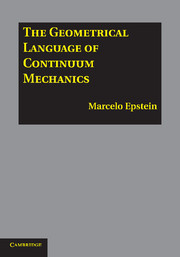4 - Differentiable Manifolds
Published online by Cambridge University Press: 05 August 2011
Summary
Having already established our physical motivation, we will proceed to provide a precise mathematical counterpart of the idea of a continuum. Each of the physical concepts of Continuum Mechanics, such as those covered in Appendix A (configuration, deformation gradient, differentiable fields on the body, and so on), will find its natural geometrical setting starting with the treatment in this chapter. Eventually, new physical ideas, not covered in our Continuum Mechanics primer, will arise naturally from the geometric context and will be discussed as they arise.
Introduction
The Greek historian Herodotus, who lived and wrote in the 5th century bce, relates that the need to reconstruct the demarcations between plots of land periodically flooded by the Nile was one of the reasons for the emergence of Geometry in ancient Egypt. He thus explains the curious name of a discipline which even in his time had already attained the status and the reputation of a pure science. For “geometry” literally means “measurement of the Earth,” and in some European languages to this very day the practitioner of land surveying is designated as geometer. In the light of its Earth-bound origins, therefore, it is perhaps not unworthy of notice that when modern differential geometers were looking for a terminology that would be both accurate and suggestive to characterize the notion of a continuum, they found their inspiration in Cartography, that is, in the science of making maps of the Earth.
- Type
- Chapter
- Information
- The Geometrical Language of Continuum Mechanics , pp. 81 - 125Publisher: Cambridge University PressPrint publication year: 2010



